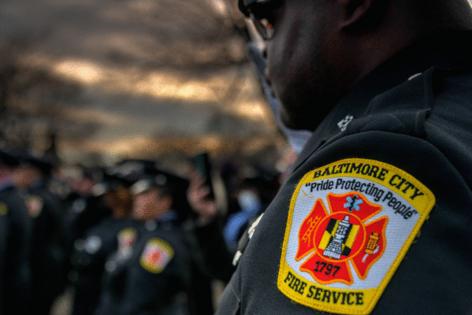Baltimore firefighters respond to up to 6,000 opioid overdoses a year, fire official testifies
Published in News & Features
BALTIMORE — The Baltimore City Fire Department responds to between 3,000 and 6,000 opioid overdoses every year, a top city fire official estimated in testimony Monday to support the city’s ongoing civil suit against two major drug distributors.
James U. Matz, the department’s assistant chief of emergency medical services, said the estimate only accounts for incidents in which medics are able to resuscitate a patient with Naloxone, which rapidly reverses the effects of an overdose. He said that estimate almost certainly undercounts the true number of opioid overdoses because many fatal overdoses aren’t identified as such until an autopsy and toxicology screening are performed by the state Office of the Chief Medical Examiner.
Matz said the opioid crisis has strained the department’s resources, leading to longer response times to emergencies.
“Overall, it’s degraded the health of Baltimore,” said Matz, an almost 30-year veteran of the fire department who grew up in the city.
Matz’s testimony came the same day attorneys for the city shared a deposition given by Mark Lichtman, who owned and ran Drug City Pharmacy in Dundalk, which was described as the largest independent pharmacy customer for oxycodone, which is distributed by McKesson, one of the firms on trial. The other is AmerisourceBergen.
The city alleges that McKesson and AmerisourceBergen were among companies that flooded the Baltimore area with addictive pain pills, creating a new generation suffering from addiction, people who went on to die at unprecedented rates when they turned to an illicit drug market replete with deadly fentanyl.
Baltimore’s 2018 lawsuit claims the actions of those companies, along with opioid manufacturers and pharmacy chains, amounted to a public nuisance under the law because it deprived residents of their right to health and safety.
In opening statements last week, an attorney for the city said McKesson sent 3 million oxycodone pills to Drug City one year before the company cut the pharmacy off in 2012 amid a Drug Enforcement Administration probe into its opioid dispensing.
Lichtman said McKesson, which sent him opioids and other drugs, never questioned him or raised concerns as it sent more and more pain pills to his pharmacy.
“They used to call me and ask me if I needed more oxys,” Lichtman said in the deposition. “They loved us. I think they thought they were getting in trouble now, so they dropped us.”
Lichtman recalled interactions with a salesman. Rather than any concern, he said, one salesman “congratulated me for being the top oxy person for McKesson.”
Attorneys for McKesson and AmerisourceBergen have said the companies are not responsible for causing an opioid epidemic which they say is attributable solely to illegal heroin and fentanyl brought to Baltimore and sold by cartels, gangs and street crews. Their companies, the lawyers said, merely distributed drugs to pharmacies so that they could fill doctors’ prescriptions.
In his testimony, Matz said he and medics and paramedics have noticed a sea change in the type of people impacted by the crisis.
In the 1990s, he said, most of the people who experienced overdoses treated by the department were middle-aged and many were experiencing homelessness. Overdose calls, he added, only came from certain parts of the city.
By the mid-2000s, Matz said, overdose patients were younger and came from all over Baltimore and beyond city limits.
“We started to see more prevalence of opioid pills,” he said.
The next decade saw “dramatically more” overdoses, Matz said, and people were dying at a higher clip from heroin and fentanyl.
“It isn’t just a heroin or a fentanyl problem,” Matz said, “it’s an opioid problem.”
_____
©2024 Baltimore Sun. Visit baltimoresun.com. Distributed by Tribune Content Agency, LLC.







Comments